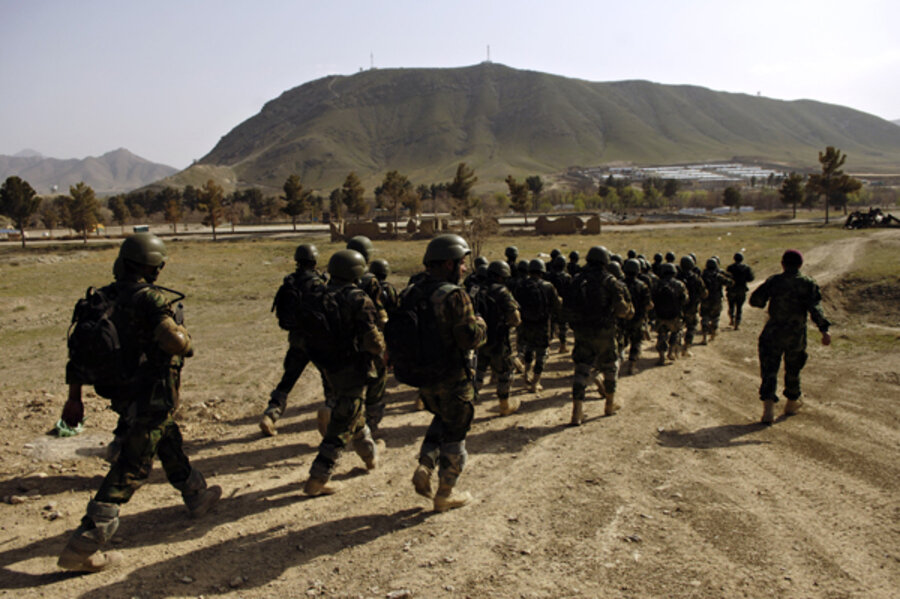Shades of Iraq in Afghanistan? Problems with shoddy contracting work
Loading...
SIGAR, the US government body assigned to audit and oversee US spending on reconstruction projects in Afghanistan, has released the latest in a series of reports detailing contractor failings with minimal accountability in Afghanistan.
The report out today focuses on $72.8 million contracted to DynCorp international by the Army Corps of Engineers to build "Camp Pamir" for the Afghan National Army in Kunduz Province, which is meant to house 1,800 Afghan soldiers. The specifics of the report are reminiscent of dozens of previous reports on US contracting in Iraq and Afghanistan over the past decade. In Iraq, contracting problems were apparent almost from the start of the war. (I wrote in June 2004 on shoddy school reconstruction in Iraq.)
When the inspector general for Iraq reconstruction closed up shop, its final report fretted that "billions" of US taxpayer money may have been wasted while enriching contractors. That there are major problems in Afghanistan as well has been long understood.
So the latest report is just a reminder that huge amounts of money have been wasted for a decade and that administrations – both Democrat and Republican – have failed to plug the leaks. The same defense and development contractors' names come up again and again on these reports and individual contracts get black marks for poor execution, but when its time to start passing out money again, they remain at the front of queue.
What happened this time?
Back in April of 2010, a SIGAR inspection warned that the buildings were being constructed on unstable, insufficiently flat ground and that drainage problems abounded. Problems apparently persisted. The Army Corps then "released DynCorp from further contractual liability in December 2011, when it entered into a settlement, paying DynCorp $70.8 million on the construction contracts and releasing it from any further liabilities and warranty obligations." SIGAR followed up with a visit in March of this year and found "additional structural failures, improper grading, and new sink holes."
On top of the cost of DynCorp's work, deadlines were missed. The first phase missed its deadline by $20 million and at a cost of $19 million more to US taxpayers. Phase two was hardly better:
"It was nearly 14 months past its completion date, the U.S. government had paid more than $51 million of the $72.8 million contracted value for construction, and ANA troops were being housed in tents outside the garrison," according to SIGAR. "In addition to the severe settling and site grading issues, we noted examples of inadequate construction quality and noncompliance with contract specifications, such as poor quality welds and rust forming on steel roof support beams and other structural bracing in barracks and other facilities on the garrison."
The report identifies ongoing sinkhole and drainage problems that will probably require more spending to fix. Though it doesn't come out and say it, the impression is of an unstable garrison that, without extensive spending, could end up a write-off after not too many more years of rain and erosion.
The report is particularly concerned that DynCorp was allowed out of its contractual responsibilities, and requests answers as to why from the Army Corps.
DynCorp contests the inspector general's analysis. "We absolutely disagree with several of the report’s conclusions concerning the causes for the issues experienced at this site,” DynCorp spokeswoman Ashley Burke told Bloomberg in an e-mail today. “Further, work was completed and this contract was closed out last year so we are unable to comment on 2012 site conditions that may or may not exist today.”
DynCorp continues to prosper. It was bought by Cerberus Capital Management for $1.5 billion in 2010 and in the second quarter of 2012 reported more than $960 million of revenue, almost all of it from US government contracting. It remains a major player in US contracting in Afghanistan and was awarded long-term business status under the US Army's Logistics Civil and Augmentation Program (LOGCAP).
In the second quarter, the company said LOGCAP revenue increased by 3.9 percent to $417.5 million "primarily as a result of continued increased demand for services under the Afghanistan task order."








